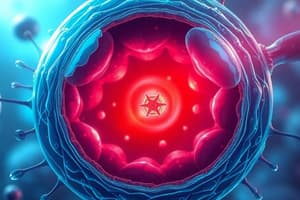Podcast
Questions and Answers
What is the primary function of the cell membrane?
What is the primary function of the cell membrane?
- To store genetic information
- To provide structural support to the nucleus
- To regulate the transport of materials into and out of the cell (correct)
- To facilitate protein synthesis
Which component of the cell membrane plays a key role in cell recognition?
Which component of the cell membrane plays a key role in cell recognition?
- Cytoplasm
- Transport proteins
- Carbohydrate chains (correct)
- Phospholipids
What is the main function of the nucleus in a cell?
What is the main function of the nucleus in a cell?
- To support cellular respiration
- To form the structural framework of the cell
- To control the cell's activities and contain DNA (correct)
- To facilitate the movement of substances across the membrane
What structural feature characterizes the cell membrane?
What structural feature characterizes the cell membrane?
What substance surrounds the nucleus and contains organelles?
What substance surrounds the nucleus and contains organelles?
Flashcards are hidden until you start studying
Study Notes
Cell Membrane
- The cell membrane (plasma membrane) is the outermost layer of a cell.
- It separates the cell's interior from the external environment.
- Regulates the movement of substances entering and leaving the cell.
- Composed of a phospholipid bilayer, proteins, and carbohydrate chains.
Nucleus
- The nucleus acts as the cell's control center.
- Contains the cell's DNA (genetic material).
Cytoplasm
- The cytoplasm (cytosol) surrounds the nucleus.
- Contains organelles (specialized structures within the cell).
- Facilitates movement of genetic material and cellular respiration products.
Cell Membrane Structure
- Phospholipids: Form the fundamental structure of the membrane.
- Proteins: Embedded within the phospholipid bilayer; some facilitate transport across the membrane (transport proteins).
- Carbohydrate Chains: Located on the membrane surface, contributing to cell-cell recognition and communication.
- Cells vary in size, shape, and function.
Studying That Suits You
Use AI to generate personalized quizzes and flashcards to suit your learning preferences.




